Jira and Confluence: Working Effectively with Both Tools
Jira and Confluence are world-class tools that each serve an array of different purposes. By combining these two tools effectively, teams can reap the rewards of enhanced synergy and collaboration and take advantage of improved communication, information access and efficiency.
An Overview of Jira and Confluence
Over 65,000 companies globally use Jira to help with project management. With Jira, companies can deal with a variety of different cases, from test case management to Agile software development. Jira offers many benefits, such as workflow customisation, roadmaps, and issue tracking.
Jira helps teams plan, assign and report work. It’s a ticket management system that can be used to manage a host of different projects. Within Jira, you can assign tickets to a relevant user, track the time spent on the ticket and mark start and end dates.
It’s the ultimate work management tool and it’s the #1 tool for Agile teams. It allows an organisation to deliver collaborative yet clear service experiences across all teams. Jira is a ‘common language’ for your organisation with templates crafted for different teams.
An organisation can also use Confluence as a tool to collaboratively edit work as a team, capture project requirements and assign tasks. With Confluence, you’re able to create and organize and collaborate your team’s knowledge in one space. The ability to access information independently can be helpful for team structure, organisation and work sharing. All team members have access to the organisation’s knowledge base and are given more autonomy and accountability for their tasks.
Collaborating in Confluence can benefit your team by simplifying engagement and authenticity at work. With Confluence as your tool, your team can make quick decisions, gain focus and achieve more as a team. Its wiki-based architecture simplifies the collection of project and team information in a single tool and permits cross-reference information between confluence spaces reducing duplicates and out-of-date copies.
How Do Jira and Confluence Work Together?
Integrating these two apps effectively can greatly streamline your team projects. Knowledge sharing is a big pro of combining both apps; this can help with both delegation and efficiency. This gives the team valuable time back to work on key aspects of the project, instead of wasting their time looking for files or re-communicating information to team members.
When a team member is assigned a Jira ticket to investigate a bug, they can simply go to Confluence and find a runbook that outlines the steps they need to take. This then doesn’t take time away from the other team members and allows a job to be done efficiently. It also improves individual autonomy and allows the team to work well together while maintaining individual accountability.
Jira and Confluence complement each other perfectly. Jira is ideal for keeping track of individual tasks and Confluence organises and centralises all documentation and collaborative content.
Both apps allow users with access to collaborate on the information in real time. This eases the collaborative process and improves workflow which is especially useful when connecting different teams.
How Combining Both Apps Can Improve Organisation:
Now that you understand the basics of each tool, it’s time to delve into the benefits of having them both work together.
Document organisation and centralisation are key to good teamwork. By combining Jira and Confluence your team can store all documents in one place meaning there is no time wasted searching through folders and drives.
Additionally, in a traditional setup, there may be inaccessible documents for certain users, combining Jira and Confluence means this doesn’t happen. For example, if a team member that is in charge of a certain document is on holiday and another user needs to access it, this won’t pose an issue within Confluence, whereas it may be an issue where documents are stored solely on devices. Confluence will keep and organise all notes and project work directly in the app; this - in turn - creates a large and varied knowledge base.
So, how does Confluence document organisation relate to Jira? Well, if your team is building strategy documents and roadmaps in Confluence they can simultaneously use Jira Epics and Tickets to define the tasks implied in the Confluence roadmaps.
For instance, if a development team is creating a roadmap for a new feature they can break this down into Jira Tickets for different team members to work on and can help delegate elements to be created. This not only helps with transparency but also shows the team how their tickets and tasks fit into the bigger picture.
By embedding your Jira Roadmap into your Confluence page you can keep your team updated; it keeps your team on the same page and creates real-time roadmap updates. This simplifies organisation for everyone by allowing status updates and planned work to be found without switching apps or having to laboriously use copy and paste to get the same information into both apps.
Here’s how to include your Jira roadmap in your Confluence documents:
1. Type /jira roadmap while editing a page
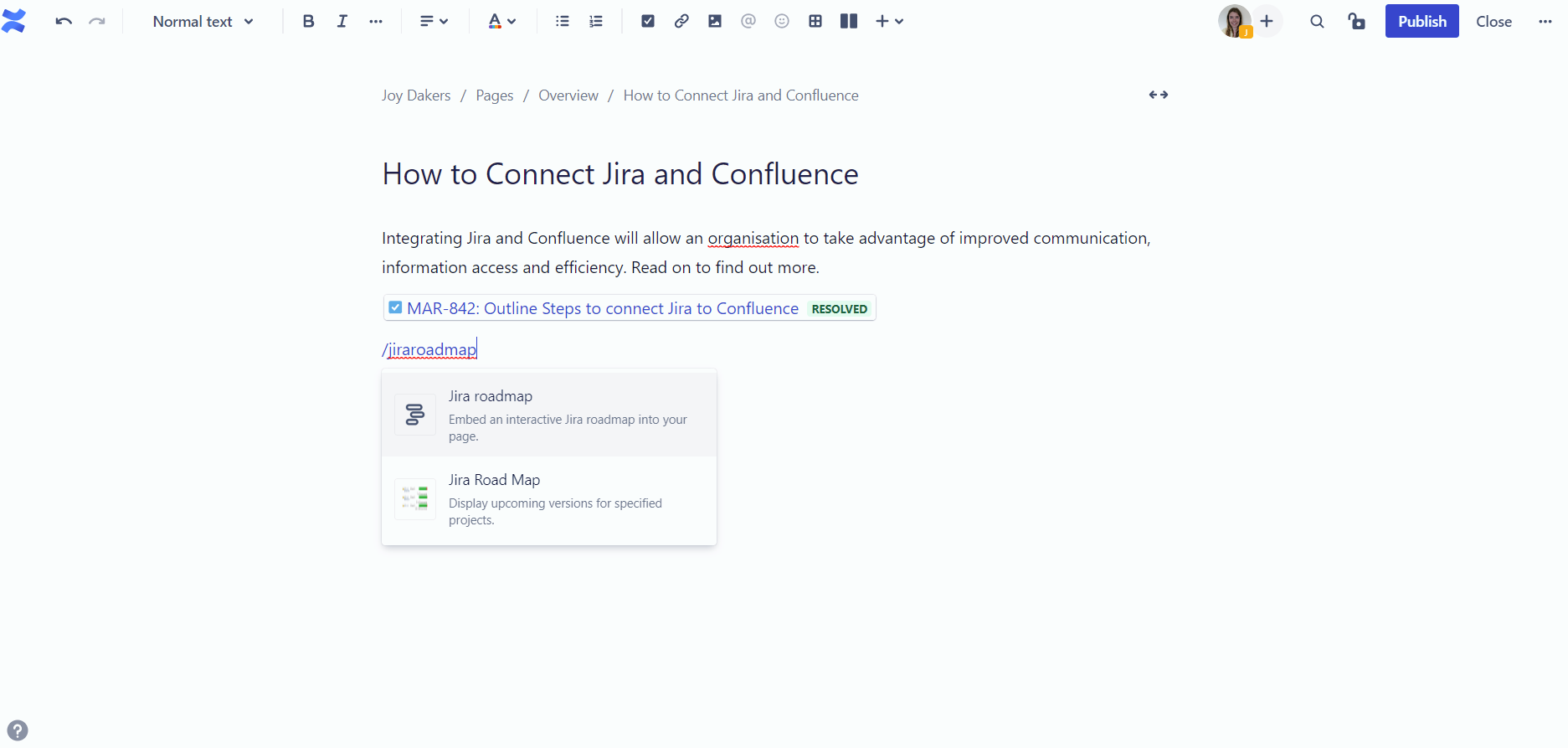
2. Paste a Jira instance URL
3. Select your project and board
4. Click ‘Save’
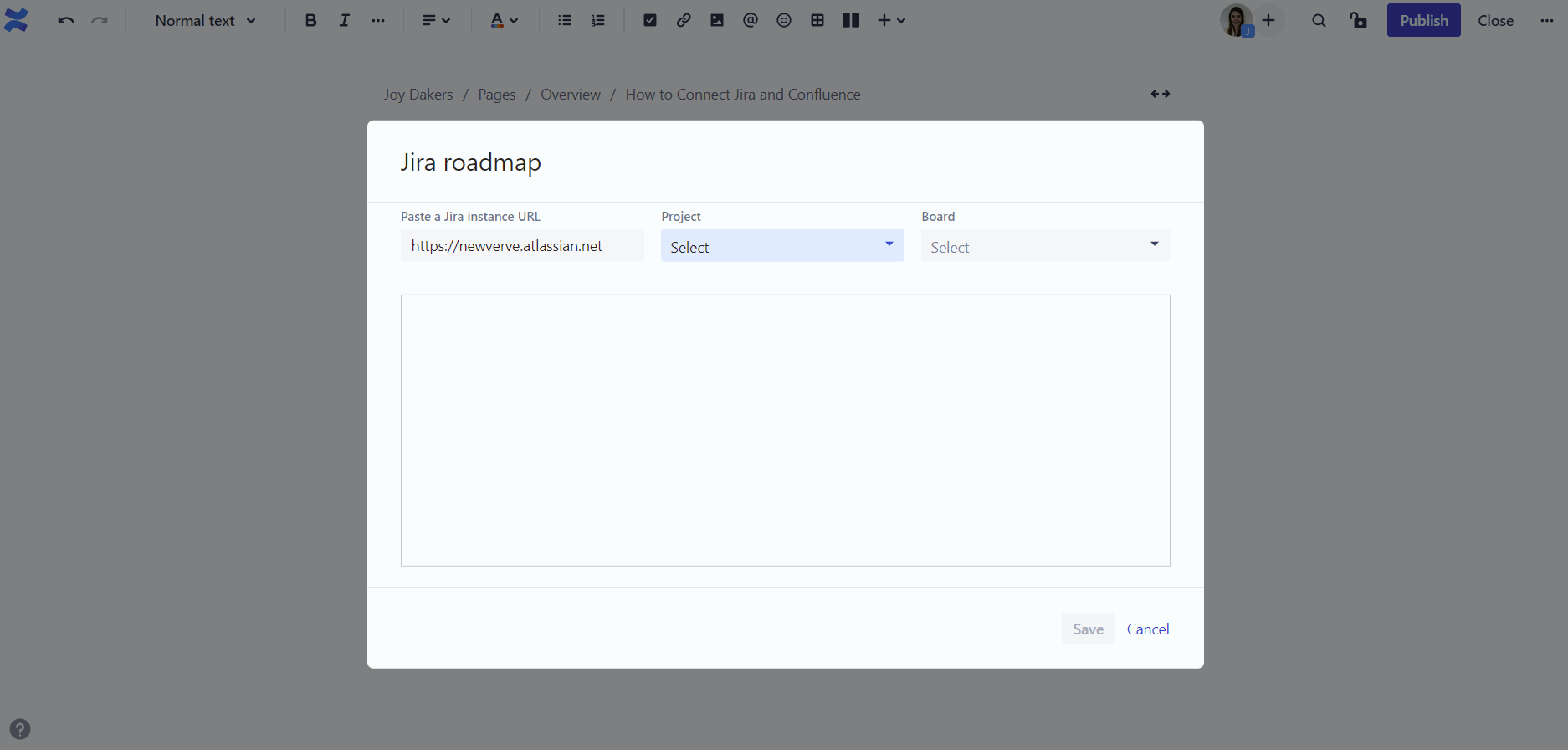
Integration applies to all teams in an organisation. The tools complement each other and combining them gives all teams the best of both worlds in terms of efficiency, project management and collaboration.
How combining both apps can improve communication:
Another benefit of integration is team progress visibility. By integrating Jira and Confluence you can boost communication between development and non-technical teams that might not communicate regularly on the same platforms.
By integrating the two apps, everybody will have access to the same information. Again, this increases transparency in your company structure and simplifies cross-team communication.
The knowledge bases that can be created through Confluence can then be used to simplify team communication and customer-accessible knowledge. By using templates in Confluence your team can set up ‘how-to’ and troubleshooting documents easily; a particularly useful tool for service teams who can then make information easily accessible to customers by making the documents public through the customer portal.
How integrating Jira and Confluence can improve your projects:
Now we’ve covered how Jira and Confluence will benefit your company’s communications and organisation, let’s talk about how integration will benefit your projects in other ways.
Integrating both apps makes reporting easier which is beneficial for team retros and stakeholder updates. A good way for your stakeholders to see a snapshot of how a project is going is to use Jira Blueprint or Jira Chart to create a visual. You can then store this information in Confluence for everyone to find easily in a centralised location.
To link your Confluence space to Jira simply follow these steps:
1. Find ‘Project pages’ in the Jira left-hand sidebar
2. Click ‘Connect to Confluence’
3. Search for the Confluence space you want to connect
For any project, it is crucial to have documentation such as instructions, reports or roadmaps. By Integrating Jira to Confluence you can link Confluence documentation to Jira issues. If you do this you will see a Jira indicator at the top of the Confluence page linking to a Jira issue someone in the team has found.
A further benefit of linking in this way is that the linked issue automatically converts to present the Jira issue in simplified text. This then clearly communicates the issue to which the link goes. This means more efficient project management and team communication as both Jira and Confluence can be linked consistently which requires little effort.
Follow these steps to connect a Jira issue to your Confluence page:
1. Type /jira while editing your page
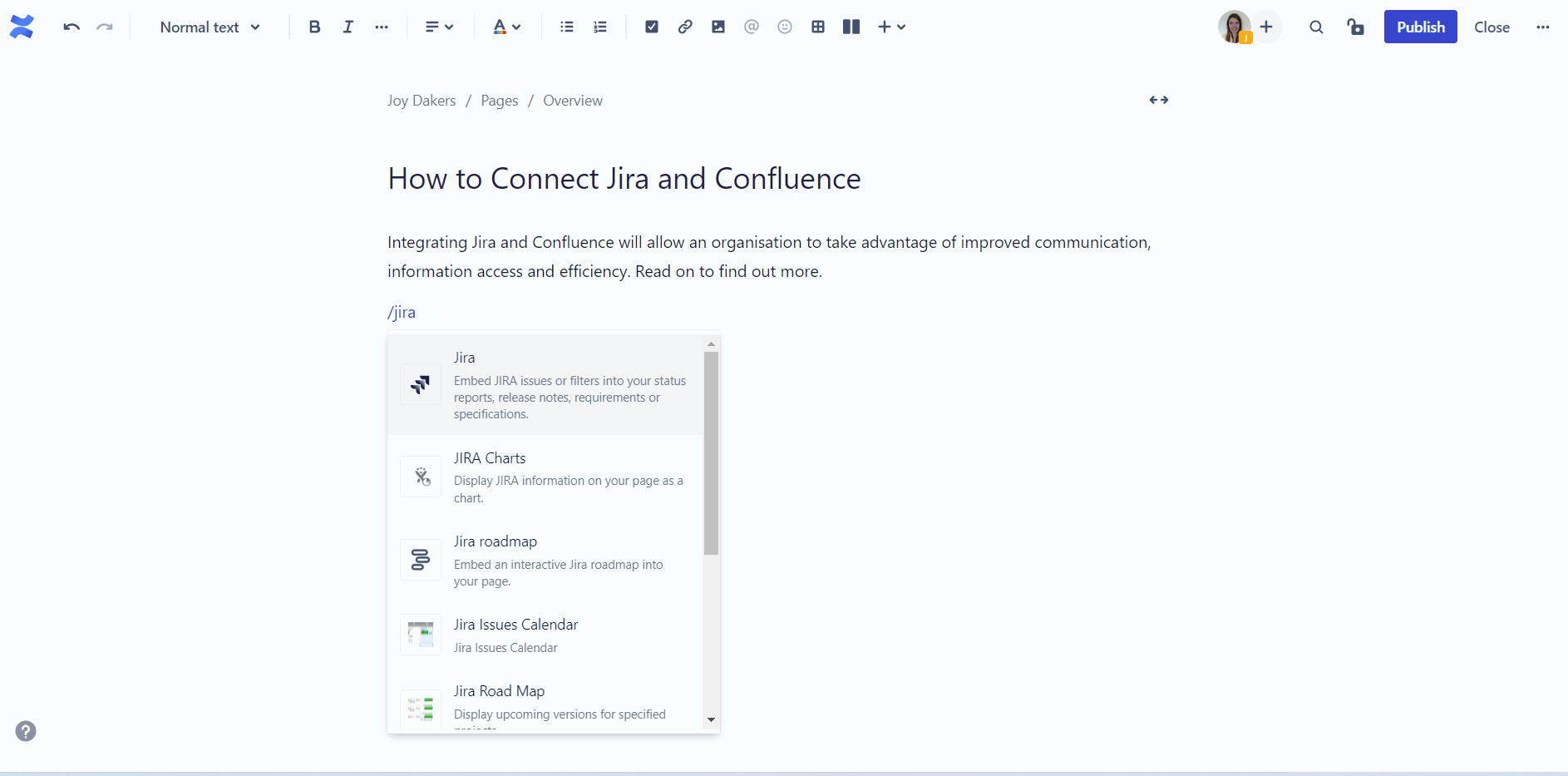
2. Use the search bar to search for Jira issues and select the issues that you would like to display on your Confluence page.
3. Select Insert
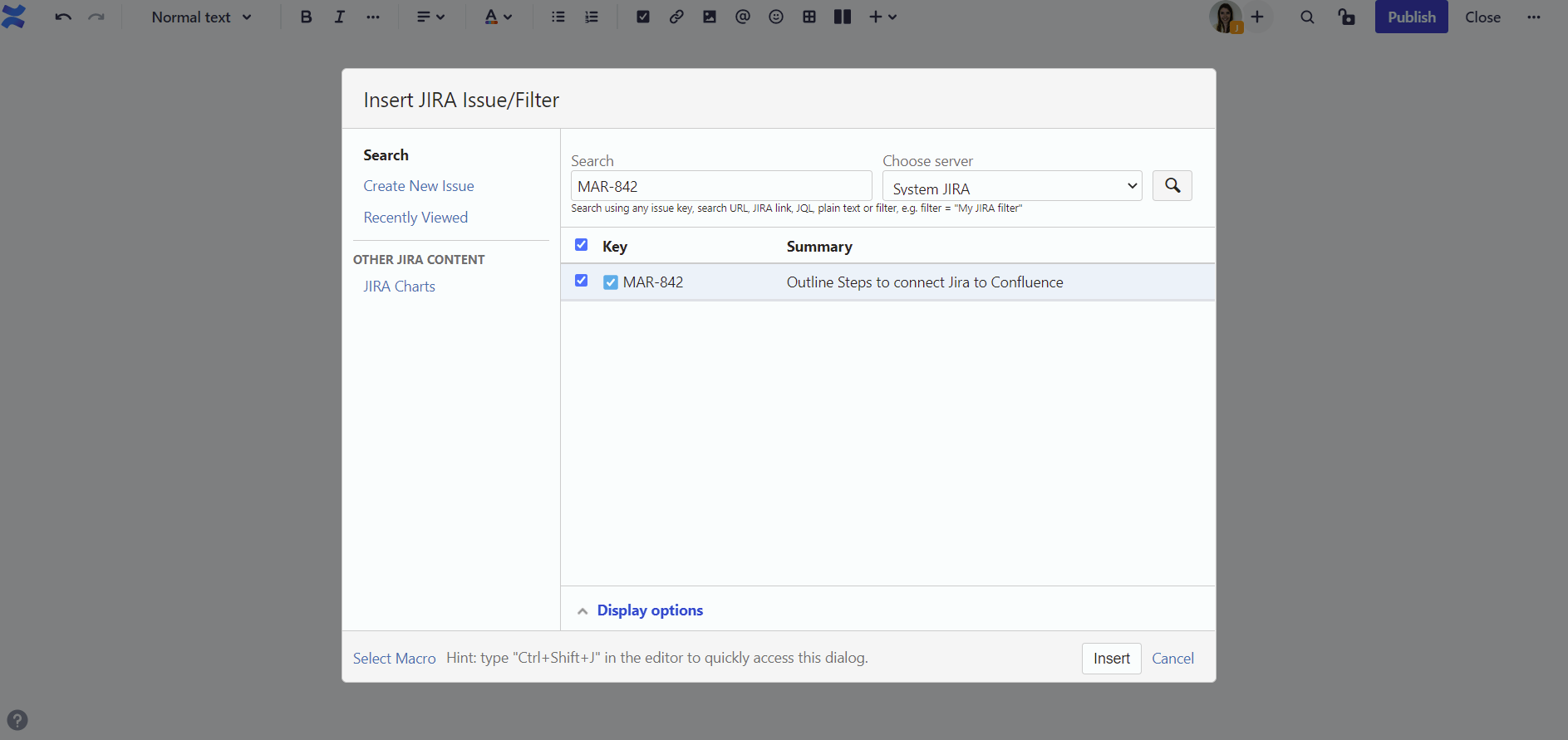
4. The pop up will disappear and you will see your embedded Jira issue within your Confluence page.
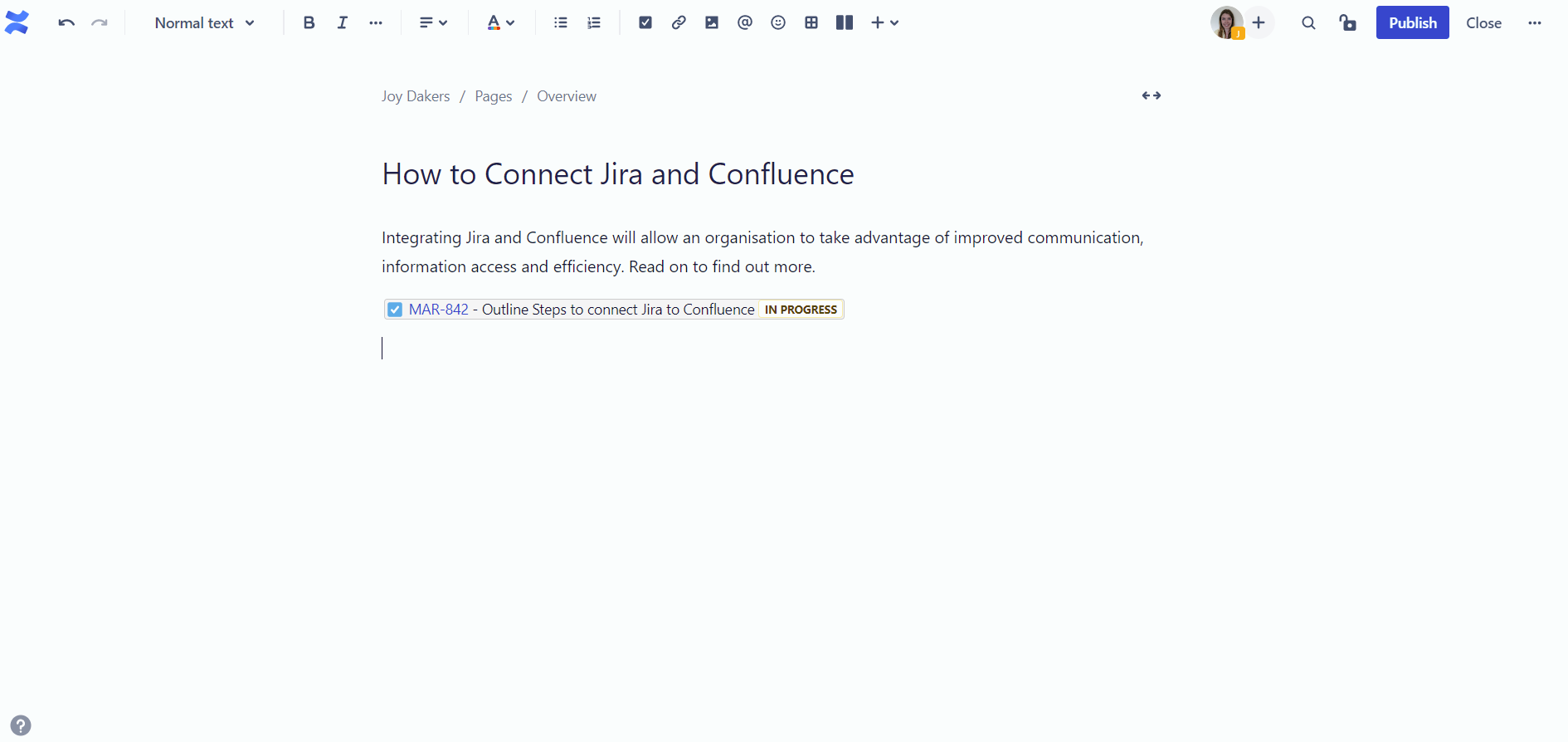
Connecting both apps benefits software teams as they can manage their sprints more efficiently. For example, in Jira, the team can create a Confluence page in Jira Software to plan the sprint. Do this using Jira Blueprint; a template that helps capture the details your team will need. This will then automatically link to the sprint. You can then link other useful Confluence pages and report on your progress. At the end of the project, the team can use a Retrospective Blueprint in Confluence to evaluate the project. This process ensures the organisation of all documents and encourages greater communication and real-time editing as a team.
Software teams can also link their project lifecycle together through both apps. You can keep all information updated in both apps simultaneously, and in one easily accessible area, by linking project documents in Confluence with project documents in Jira. By integrating both tools, a team can improve information tracking, sprint management, and time management.
Summary
We’ve just highlighted a few of the ways integrating Jira and Confluence can make an impact on your company. Together, they produce effective time management as well as communication and organisation advantages. Connecting Jira and Confluence is sure to make your team more efficient!
If you think your teams would benefit from optimising communication, project management and teamwork, let us help! Contact us for more information on creating the ideal, tailored Atlassian solutions for you.
Recommended Reading
If you enjoyed this blog you may like Tips and Tricks for Successful Jira Project Management.

Comments:
There are no comments for this entry yet.